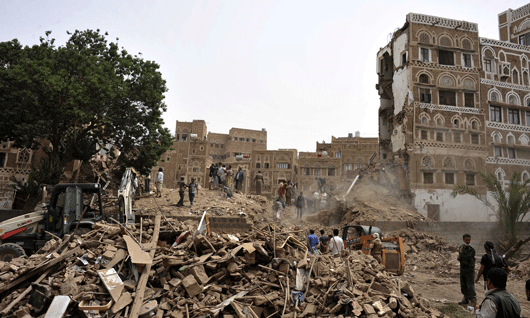
By Asa Fitch and Mohammad AL-Kibsi
"I kept shouting the names of my son Yahya and his brother-in-law but no one answered," Mr. Asabah, 67 years old, said. "Later we found them killed by the rubble a few meters away."
Residents said the blast, one of several reported in Sana’a that Friday night in September, left a crater consistent with damage caused by airstrikes carried out by the Saudi Arabia-led military coalition against the Houthi Ansarullah movement ..., a revolutionary group that ousted Yemen’s Saudi-backed president in March.
UNESCO, the United Nations agency that focuses on culture and historical preservation and has designated the Old City of Sana’a as a World Heritage site, called the attack an aerial bombing in a statement condemning the strike.
The coalition didn’t respond to requests to comment on whether it was responsible for the explosion.
But the growing civilian death toll after eight months of war-and the coalition’s unwillingness to investigate and report on the damage caused by its strikes- have drawn the scrutiny of the U.N. and human-rights activists, who are questioning the targeting strategy of Saudi Arabia’s air campaign.
The high civilian toll has marred Saudi Arabia’s largest-ever military operation, the hallmark of the newly aggressive security policy being overseen by 29-year-old Defense Minister Mohammed bin Salman, and risks stoking anger among a population already weary of war. It is also testing the patience of the U.S., a longtime ally that is providing logistical and intelligence support.
While civilian casualties are inevitable in any armed conflict, the Saudi coalition strikes have been particularly dangerous for noncombatants. More than 2,600 civilians have died since March, from both airstrikes and clashes..., according to United Nations’ estimates. A September report by the U.N. High Commissioner for Human Rights concluded that by the end of June almost two-thirds of civilians killed in the Yemeni conflict had died as a result of airstrikes.
The coalition "is not taking enough precautions to avoid civilian casualties," said Ole Solvang, a senior researcher at Human Rights Watch who has been to Yemen to investigate civilian deaths.
Last week, international medical-aid group Doctors Without Borders said an airstrike hit its mobile clinic in the southern city of Taiz, wounding nine. It was the second time the group has said its facilities have been struck. In late October, it said at least two airstrikes hit its health facility in northern Yemen while patients and staff were inside, although nobody died.
The coalition has said it would form a committee to investigate the Taiz attack, suggesting the coalition may be responding to criticism from rights groups for not carrying out the kind of inquiry the U.S. did after one of its airstrikes hit a Doctors Without Borders hospital in Afghanistan. That investigation determined human error was responsible for the attack, which killed 30 people.
The coalition has previously denied it was responsible for the destruction of the Doctors Without Borders health facility in October, although it said at the time that Yemeni authorities would carry out an investigation.
Among other major attacks the coalition has denied carrying out are an explosion at a wedding party in the southwestern city of Mocha on Sep. 29 that killed more than 130 people and a June explosion that killed five in the Old City of Sana’a. The coalition said its planes weren’t in the vicinity.
The Saudi-led coalition has rejected the allegations of flawed targeting. Saudi officials say the coalition uses precision weapons on targets that are "identified and scrutinized by a multinational council that meticulously vets target coordinates," according to a statement by Saudi Arabia’s U.K. Embassy in October.
"The coalition has not intentionally bombed civilians and any accusation of such intentions is a false claim spread by those who support the rebels attempting to wreak havoc in Yemen," it said.
The coalition, composed of Saudi Arabia and several mostly Arab allies, began strikes in March ... The coalition views the Ansarullah ... as a proxy for Iran, its main rival in the region. Iran has given the Houthis political support but denies supplying them with weapons. U.N.-brokered efforts to negotiate a lasting peace have faltered repeatedly.
The campaign has bogged down in recent weeks, as the coalition and its allied Yemeni forces encounter resistance in Taiz, a large city about 200 miles south of Sana’a by road.
"The Saudi equipment is where it needs to be, but they have not mastered how to use it," said Katherine Zimmerman, a research fellow at the Washington-based think tank the American Enterprise Institute.
The U.S. has been giving the coalition logistical and intelligence help through a joint planning cell established after the strikes began. It doesn’t select or sign off on targeting decisions, according to a spokeswoman for the U.S. Central Command, which coordinates military activities in the region.
"We have consistently reinforced to coalition members the imperative of target analysis and precise application of weapons in order to identify and avoid structures and areas that, if struck, could result in civilian casualties," the spokeswoman said.
In the Old City of Sana’a, people are still puzzled by the strike that killed many members of the al-Aini family. The al-Ainis had no links to the Ansarullah, nor were there revolutionaries ... in the neighborhood at the time of the explosion, residents say.
Subiha al-Maswari, an al-Aini relative, said she was helping her disabled husband lay down on his bed when she felt the thud of the missile. She fainted as pieces of wood and gypsum fell from the ceiling, and later awoke as she was being pulled from the rubble.
"We had nothing to do with politics," she said. "Now we have nothing."